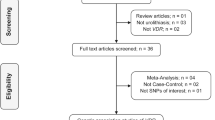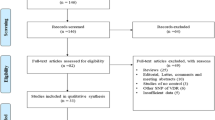Abstract
To investigate the effect of the vitamin D receptor (VDR) Fok I Bsm I Dde I Apa I Taq I polymorphism on the clinical presentation of calcium urolithiasis, 464 patients with urolithiasis and 450 age- and sex-matched healthy controls were recruited from The First Affiliated Hospital of Zhejiang University between January 2010 and March 2011. Five SNPs of VDR polymorphism were detected using polymerase chain reaction-based restriction analysis. The frequency of VDR Apa I genotypes between the patients and the healthy controls was significantly different (P = 0.006). Apa I a allele was found to be associated with increased risk of stone recurrence (P = 0.028). We also found Fok I Dde I Apa I showed a significant difference between male and female in the patients group (P < 0.05). Haplotype analysis of the five VDR polymorphisms showed a significant association with urolithiasis (global-P value = 0.0001). Genetic polymorphisms of VDR are important in the clinical presentation of patients with calcium urolithiasis in the Han population of southern China.

Similar content being viewed by others
References
Lee YH, Huang WC, Tsai JY, Lu CM, Chen WC, Lee MH, Hsu HS, Huang JK, Chang LS (2002) Epidemiological studies on the prevalence of upper urinary calculi in Taiwan. Urol Int 68(3):172–177. pii: 48445
Worcester EM, Coe FL (2010) Clinical practice. Calcium kidney stones. N Engl J Med 363(10):954–963. doi:10.1056/NEJMcp1001011
Valdivielso JM, Fernandez E (2006) Vitamin D receptor polymorphisms and diseases. Clin Chim Acta 371(1–2):1–12
Curhan GC, Willett WC, Rimm EB, Stampfer MJ (1997) Family history and risk of kidney stones. J Am Soc Nephrol 8(10):1568–1573
Coe FL, Parks JH, Asplin JR (1992) Medical Progress—the pathogenesis and treatment of kidney-stones. New Engl J Med 327(16):1141–1152
Gornes SA, dos Reis LM, Noronha IL, Jorgetti V, Heilberg IP (2008) RANKL is a mediator of bone resorption in idiopathic hypercalciuria. Clin J Am Soc Nephrol 3(5):1446–1452. doi:10.2215/Cjn.00240108
Tiselius HG, Hojgaard I (1999) Some aspects of the intratubular precipitation of calcium salts. J Am Soc Nephrol 10:S371–S375
Li XQ, Tembe V, Horwitz GM, Bushinsky DA, Favus MJ (1993) Increased intestinal vitamin-D receptor in genetic hypercalciuric rats—a cause of intestinal calcium hyperabsorption. J Clin Invest 91(2):661–667
Krieger NS, Stathopoulos VM, Bushinsky DA (1996) Increased sensitivity to 1, 25(OH)2D3 in bone from genetic hypercalciuric rats. Am J Physiol 271(1 Pt 1):C130–C135
Lin Y, Mao Q, Zheng X, Chen H, Yang K, Xie L (2011) Vitamin D receptor genetic polymorphisms and the risk of urolithiasis: a meta-analysis. Urol Int 86(3):249–255. doi:10.1159/000323949
Manolio TA, Collins FS (2009) The HapMap and genome-wide association studies in diagnosis and therapy. Annu Rev Med 60:443–456. doi:10.1146/annurev.med.60.061907.093117
Nakamura Y (2009) DNA variations in human and medical genetics: 25 years of my experience. J Hum Genet 54(1):1–8. doi:10.1038/jhg.2008.6
Gross C, Krishnan AV, Malloy PJ, Eccleshall TR, Zhao XY, Feldman D (1998) The vitamin D receptor gene start codon polymorphism: a functional analysis of Fok I variants. J Bone Miner Res 13(11):1691–1699. doi:10.1359/jbmr.1998.13.11.1691
Morrison NA, Qi JC, Tokita A, Kelly PJ, Crofts L, Nguyen TV, Sambrook PN, Eisman JA (1994) Prediction of bone-density from Vitamin-D receptor alleles. Nature 367(6460):284–287
Whitfield GK, Remus LS, Jurutka PW, Zitzer H, Oza AK, Dang HT, Haussler CA, Galligan MA, Thatcher ML, Encinas Dominguez C, Haussler MR (2001) Functionally relevant polymorphisms in the human nuclear vitamin D receptor gene. Mol Cell Endocrinol 177(1–2):145–159 (pii: S0303720701004063)
Miyamoto K, Kesterson RA, Yamamoto H, Taketani Y, Nishiwaki E, Tatsumi S, Inoue Y, Morita K, Takeda E, Pike JW (1997) Structural organization of the human vitamin D receptor chromosomal gene and its promoter. Mol Endocrinol 11(8):1165–1179
Shi YY, He L (2005) SHEsis, a powerful software platform for analyses of linkage disequilibrium, haplotype construction, and genetic association at polymorphism loci. Cell Res 15(2):97–98
Barrett JC, Fry B, Maller J, Daly MJ (2005) Haploview: analysis and visualization of LD and haplotype maps. Bioinformatics 21(2):263–265
Bid HK, Chaudhary H, Mittal RD (2005) Association of vitamin-D and calcitonin receptor gene polymorphism in paediatric nephrolithiasis. Pediatr Nephrol 20(6):773–776. doi:10.1007/s00467-005-1846-4
Bid HK, Kumar A, Kapoor R, Mittal RD (2005) Association of vitamin D receptor-gene (Fok I) polymorphism with calcium oxalate nephrolithiasis. J Endourol 19(1):111–115. doi:10.1089/end.2005.19.111
Ferreira LG, Pereira AC, Heilberg IP (2010) Vitamin D receptor and calcium-sensing receptor gene polymorphisms in hypercalciuric stone-forming patients. Nephron Clin Pract 114(2):c135–c144. doi:10.1159/000254386
Gunes S, Bilen CY, Kara N, Asci R, Bagci H, Yilmaz AF (2006) Vitamin D receptor gene polymorphisms in patients with urolithiasis. Urol Res 34(1):47–52. doi:10.1007/s00240-005-0033-1
Mittal RD MD, Srivastava P (2010) Polymorphisms in the vitamin D receptor and the androgen receptor gene associated with the risk of urolithiasis. Indian J Clin Biochem 25
Mossetti G, Vuotto P, Rendina D, Numis FG, Viceconti R, Giordano F, Cioffi M, Scopacasa F, Nunziata V (2003) Association between vitamin D receptor gene polymorphisms and tubular citrate handling in calcium nephrolithiasis. J Intern Med 253(2):194–200
Nishijima S, Sugaya K, Naito A, Morozumi M, Hatano T, Ogawa Y (2002) Association of vitamin D receptor gene polymorphism with urolithiasis. J Urology 167(5):2188–2191
Seo IY, Kang IH, Chae SC, Park SC, Lee YJ, Yang YS, Ryu SB, Rim JS (2010) Vitamin D receptor gene Alw I, Fok I, Apa I, and Taq I polymorphisms in patients with urinary stone. Urology 75(4):923–927. doi:10.1016/j.urology.2009.10.006
Vezzoli G, Soldati L, Proverbio MC, Adamo D, Rubinacci A, Bianchi G, Mora S (2002) Polymorphism of vitamin D receptor gene start codon in patients with calcium kidney stones. J Nephrol 15(2):158–164
Zhu CX, Ye ZQ, Chen ZQ, Xia D, Hu J (2010) Association between Vitamin D receptor gene polymorphisms and idiopathic hypocitraturia in the Chinese population. Urol Int 85(1):100–105
Evans RM (1988) The steroid and thyroid-hormone receptor superfamily. Science 240(4854):889–895
Haussler MR, Whitfield GK, Haussler CA, Hsieh JC, Thompson PD, Selznick SH, Dominguez CE, Jurutka PW (1998) The nuclear vitamin D receptor: biological and molecular regulatory properties revealed. J Bone Miner Res 13(3):325–349
Jones G, Strugnell SA, DeLuca HF (1998) Current understanding of the molecular actions of vitamin D. Physiol Rev 78(4):1193–1231
Simpson DP (1983) Citrate excretion—a window on renal metabolism. Am J Physiol 244(3):F223–F234
Chen WC, Chen HY, Hsu CD, Wu JY, Tsai FJ (2001) No association of vitamin D receptor gene BsmI polymorphisms with calcium oxalate stone formation. Mol Urol 5(1):7–10
Holt SK, Kwon EM, Koopmeiners JS, Lin DW, Feng Z, Ostrander EA, Peters U, Stanford JL (2010) Vitamin D pathway gene variants and prostate cancer prognosis. Prostate 70(13):1448–1460. doi:10.1002/pros.21180
Acknowledgments
This study was supported by grants from the National Natural Science Foundation of China (Grant No. 30801370).
Author information
Authors and Affiliations
Corresponding author
Rights and permissions
About this article
Cite this article
Wang, S., Wang, X., Wu, J. et al. Association of vitamin D receptor gene polymorphism and calcium urolithiasis in the Chinese Han population. Urol Res 40, 277–284 (2012). https://doi.org/10.1007/s00240-011-0438-y
Received:
Accepted:
Published:
Issue Date:
DOI: https://doi.org/10.1007/s00240-011-0438-y




